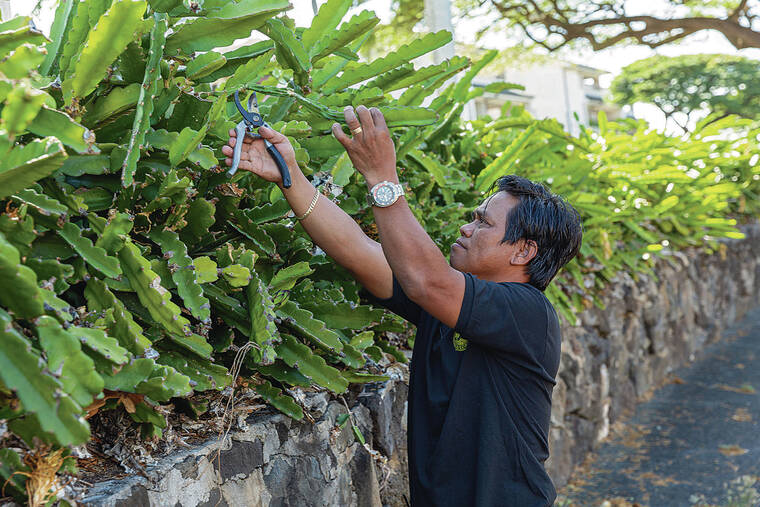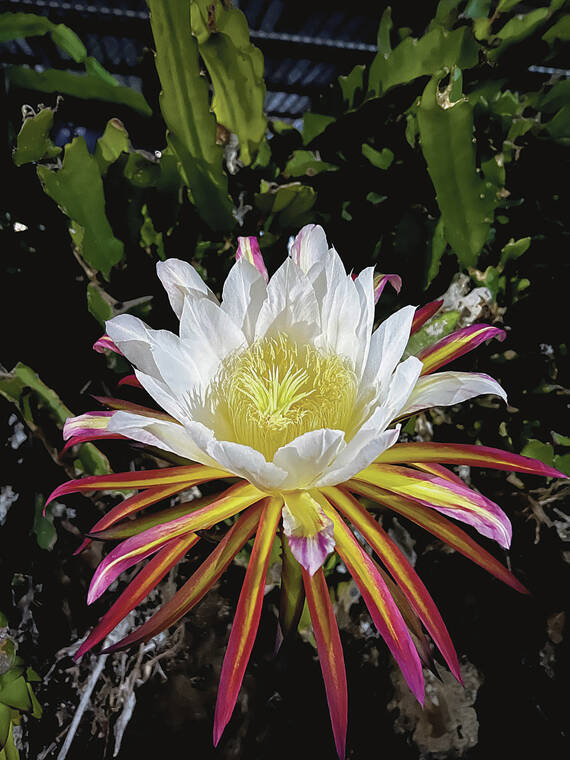Fleeting beauty: Cereus blossoms reveal themselves once a year

COURTESY RACHEL BREITWESER, PUNAHOU SCHOOL
Punahou School’s longtime grounds supervisor Michel Sebastian prunes the night-blooming cereus hedges on Wilder Avenue.

COURTESY RACHEL BREITWESER, PUNAHOU SCHOOL
Night-blooming cereus unfurl at Punahou School.

COURTESY RACHEL BREITWESER, PUNAHOU SCHOOL
Night-blooming cereus unfurl at Punahou School.



Like Cinderella in the fairy tale, the flowers of the night-blooming cereus get one chance to emerge from the shadows and blossom into full glory in the evening hours — the reason behind romantic nicknames like the “Cinderella plant,” the “queen” or “princess of the night.”
For most of the year, the prickly cactus is like an ugly stepsister, an untidy tangle of long, jointed stems that cling and scratch to climb high. But from June through October, cereus’ large, dramatic flowers, almost 7 inches across, come out to dance in the evening, bursting with fragrance. They unfurl their creamy white petals with yellow centers once the sun goes down and stay open well beyond the midnight hour (unlike Cinderella’s coach). The spell is broken with the morning light, when the flowers wither and die.
The most famous example of the night-blooming cereus in the islands is at Punahou School in Makiki: An entire hedge — 985 feet long — climbs a rock wall bordering the campus. Missionary founders, the Rev. Hiram Bingham and his wife, Sybil, planted the cactus in 1836 before the school opened in 1842. It was brought by a friend who had traveled from Mexico, according to Punahou archives, and became an enduring symbol of the school.
This particular species of night-blooming cereus is Selenicereus undatus, which produces a red fruit called the pitaya (also known as dragon fruit).
Michel Sebastian, head grounds supervisor at Punahou, said it’s been easy to keep the hedge healthy over the 25 years he has worked at the school but acknowledges it was thriving long before he arrived. Many of the main stems are as thick as a man’s forearm. The flowers usually start blooming steadily in July for two or three months, more prolifically on the oldest sections, he said.
The plant will not produce blossoms until it’s about 3 to 5 years old, and without the flowers in bloom, he admits, “It’s not pretty.” All the more reason to look forward to the blooming season, when he can enjoy their fleeting beauty when he arrives at 5 a.m. The cereus is there mainly to protect the boundary and to discourage people from climbing over the wall, Sebastian said.
Don't miss out on what's happening!
Stay in touch with breaking news, as it happens, conveniently in your email inbox. It's FREE!
When the weather is very hot, the top sections become dehydrated and shrink. Although the cereus needs a lot of sun and not much water, sprinklers turned on for several minutes daily keep the mulch at the base moist, he said. The hedge does fine without fertilizer and produces fruit that staff and passersby look forward to picking.
Sebastian’s staff prunes the hedge back about three times a year, donning gloves to protect against the thorns, when it starts growing over the sidewalk. The cuttings are easy to propagate. His gardeners plant the cuttings right into the ground to fill in the hedge’s empty spots.
Amy Teves, a volunteer with the University of Hawaii’s Master Gardener program since 2009, has been growing the night-blooming cereus at home for about as long. Her “monster” plant is over 12 feet high and is constantly reaching over a gate and through a fence in her side yard. It grew large just out of a one-gallon pot and is now in the ground. The cereus doesn’t mind being root bound and does better in smaller pots that just accommodate the roots, Teves said.
She waters her cereus daily, which is more often than most cactus require, but she concentrates the spray on the leaves (flattened stems), which send out adventitious roots (forming from the stems or leaves), that cling to walls and trellises and absorb nutrients and water.
“Cacti and succulents are not heavy feeders so an all-purpose fertilizer works fine. Frankly, too much fertilizer will create rank growth. Soil should be free draining. Cactus soil works fine. I live in a very wet place, so I use cinder and fertilize with Osmocote (NPK 14-14-14) maybe twice a year, and Miracle-Gro (24-8-16) on occasion,” Teves said.
“It does like to have good morning sun, but have shade from the middle-day sun or the leaves may turn yellow from sunburn. The roots for sure are better in the shade. The leaves will seek the light they need.”
Her cereus first starts blooming in June and usually continues until the fall. The buds mature and bloom over a period of a few days with one to three blooms opening on successive nights. The flowers start to unfurl after the sun goes down and don’t fully open till 9 or 10 p.m.
That’s when Teves hand-pollinates them with a small brush, a practice she only recently began, to produce dragon fruit more consistently. In general, fragrant white flowers that bloom primarily at night are pollinated by night pollinators, primarily the sphinx moth, and sometimes beetles, she said.
“Bees don’t fly at night, and they don’t see white flowers very well unless they are massed,” she said. Sometimes bees can be seen in the early morning, “but they are mainly interested in pollen; the nectar sac is beyond the reach of the bees, so any pollen transfer will be serendipitous.”
Is there a gardening topic you’d like to read about in the Garden Variety column? Email Pat Gee at pgee@staradvertiser.com with your request.



